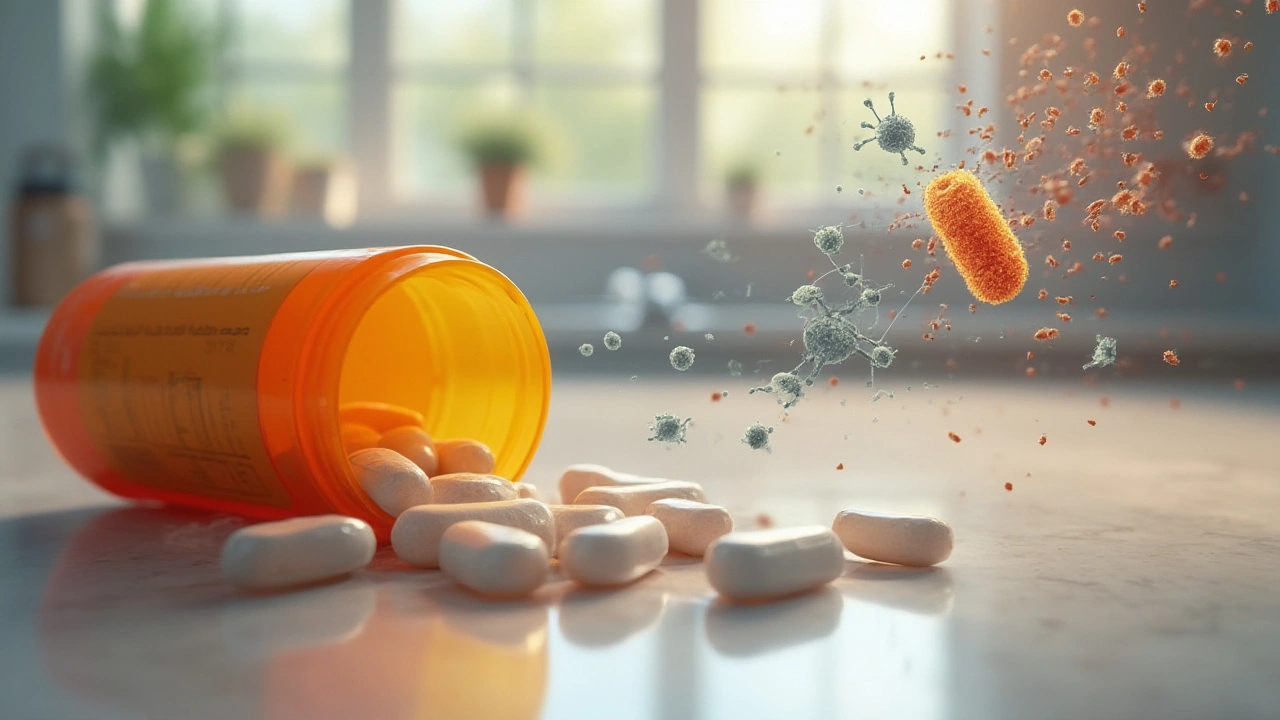Antibiotic resistance isn’t just a future threat-it’s happening right now. Every year, more common infections like ear infections, sinus infections, and pneumonia become harder to treat because the bacteria have learned to shrug off the drugs we once relied on. Among the tools still working in this fight is cefaclor, a second-generation cephalosporin antibiotic that continues to play a quiet but vital role in treating resistant bacterial strains.
What Is Cefaclor and How Does It Work?
Cefaclor is a beta-lactam antibiotic, part of the cephalosporin family. It’s not new-first approved in the 1970s-but it still works against many bacteria that have grown resistant to older penicillins. Unlike broad-spectrum antibiotics that hit everything, cefaclor targets specific types of bacteria, especially Gram-positive and some Gram-negative strains.
It works by blocking the bacteria’s ability to build their cell walls. Without a strong wall, the bacteria swell, burst, and die. This mechanism is why cefaclor remains effective against strains that have developed resistance to amoxicillin or other penicillin-based drugs. Many of these resistant strains carry enzymes called beta-lactamases that break down penicillins, but cefaclor’s chemical structure makes it harder for those enzymes to destroy it.
In clinical use, cefaclor is often prescribed for middle ear infections in children, sinus infections, throat infections like strep throat, and mild to moderate pneumonia. It’s taken orally, usually as a capsule or liquid, which makes it practical for outpatient care.
Why Cefaclor Still Matters in the Age of Resistance
When doctors see a patient with a suspected bacterial infection, they don’t automatically reach for the strongest antibiotic. They start with something targeted. That’s where cefaclor fits in. Studies from the CDC and European Centre for Disease Prevention and Control show that in regions where penicillin-resistant Streptococcus pneumoniae is common, cefaclor still achieves over 85% clinical success in treating respiratory infections.
One 2023 study in the Journal of Antimicrobial Chemotherapy tracked 1,200 pediatric cases of acute otitis media in Europe. When amoxicillin failed due to resistance, switching to cefaclor resolved symptoms in 92% of cases within five days. That’s not because cefaclor is a miracle drug-it’s because it’s still in the right place at the right time.
It’s also less disruptive to gut bacteria than broader antibiotics like fluoroquinolones or third-generation cephalosporins. That means fewer cases of antibiotic-associated diarrhea or C. difficile infections. In an era where preserving the microbiome matters as much as killing pathogens, that’s a real advantage.
Cefaclor vs. Other Antibiotics: A Quick Comparison
Not all antibiotics are created equal. Here’s how cefaclor stacks up against common alternatives:
| Antibiotic | Effective Against Penicillin-Resistant Strains? | Oral Availability | Common Side Effects | Resistance Risk |
|---|---|---|---|---|
| Cefaclor | Yes | High | Mild diarrhea, nausea | Low to moderate |
| Amoxicillin | No | High | Diarrhea, rash | High |
| Azithromycin | Yes | High | Stomach cramps, nausea | Rising |
| Cefdinir | Yes | High | Diarrhea, headache | Low |
| Levofloxacin | Yes | High | Tendon damage, nerve issues | Very high |
As the table shows, cefaclor strikes a balance. It’s more effective than amoxicillin against resistant strains, safer than fluoroquinolones, and less likely to drive widespread resistance than macrolides like azithromycin. It’s not the first choice for every infection, but for many common ones, it’s the smart middle ground.

When Cefaclor Doesn’t Work
Even the best tools have limits. Cefaclor is ineffective against certain bacteria, including:
- Methicillin-resistant Staphylococcus aureus (MRSA)
- Enterococcus species
- Most Pseudomonas aeruginosa strains
- Bacteria producing extended-spectrum beta-lactamases (ESBLs)
If a patient doesn’t improve after 48 hours on cefaclor, the infection may be caused by one of these resistant types-or it might not be bacterial at all. Viral infections like the common cold or flu don’t respond to any antibiotic, and using cefaclor in those cases only adds to resistance problems.
Doctors now use rapid diagnostic tests more often to tell bacterial from viral infections before prescribing. In places with good access to testing, like New Zealand and parts of Europe, unnecessary cefaclor prescriptions have dropped by nearly 30% over the last five years.
How Misuse Fuels Resistance-Even With Cefaclor
Cefaclor isn’t immune to the damage caused by misuse. Taking it when you don’t need it, not finishing the full course, or using leftover pills from a previous infection all contribute to resistance. Bacteria that survive partial treatment pass on their resistance genes to future generations.
One real-world example: In 2022, a hospital in Dunedin found that 18% of community-acquired E. coli isolates from urinary tract infections showed reduced susceptibility to cefaclor. That wasn’t because cefaclor was overused locally-it was because patients had taken it abroad, where prescribing rules are looser, and brought resistant strains back home.
Resistance doesn’t respect borders. It spreads through travel, food, and even water. That’s why global surveillance networks track resistance patterns. Cefaclor’s effectiveness is monitored closely because it’s still a frontline option in many countries.

What You Can Do to Help
You can’t stop antibiotic resistance alone-but you can help slow it down:
- Never take antibiotics without a prescription.
- Don’t pressure your doctor for antibiotics if they say it’s likely viral.
- Finish every course you’re given, even if you feel better.
- Don’t save leftover antibiotics for later.
- Wash your hands regularly and stay up to date on vaccines.
These steps reduce the need for antibiotics in the first place. Fewer infections mean fewer prescriptions, which means fewer chances for bacteria to evolve resistance.
The Future of Cefaclor
Cefaclor won’t solve antibiotic resistance on its own. But as long as it remains effective against common infections, it will keep being used-not because it’s flashy, but because it’s reliable. Researchers are now looking at combining cefaclor with beta-lactamase inhibitors, similar to how amoxicillin is paired with clavulanate. Early lab results show promise in restoring its power against some resistant strains.
For now, the best strategy is simple: use cefaclor wisely. When it’s the right tool for the job, it saves lives. When it’s misused, it becomes useless. The line between saving and wasting it is thin-and it’s up to all of us to stay on the right side.
Is cefaclor safe for children?
Yes, cefaclor is commonly prescribed for children for infections like ear infections, strep throat, and pneumonia. It’s available as a liquid suspension, making it easy to dose by weight. Side effects are usually mild, such as upset stomach or diarrhea, and serious reactions are rare. Always follow the prescribed dose based on the child’s weight and age.
Can you take cefaclor if you’re allergic to penicillin?
About 10% of people with a penicillin allergy may also react to cephalosporins like cefaclor. If you’ve had a serious reaction to penicillin-like anaphylaxis, swelling, or hives-your doctor will likely avoid cefaclor and choose a different class of antibiotic. For mild rashes, they may still consider it after careful evaluation. Always tell your provider about any drug allergies.
How long does it take for cefaclor to work?
Most people start feeling better within 24 to 48 hours of starting cefaclor. But feeling better doesn’t mean the infection is gone. It’s critical to finish the full course, usually 7 to 10 days, to kill all the bacteria and prevent resistance from developing.
Does cefaclor interact with other medications?
Cefaclor can interact with probenecid, a drug used for gout, which may increase cefaclor levels in the blood. It can also reduce the effectiveness of live bacterial vaccines like the typhoid vaccine. Always tell your doctor about all medications and supplements you’re taking before starting cefaclor.
Is cefaclor still used in hospitals?
Cefaclor is mainly used in outpatient settings because it’s taken by mouth. Hospitals typically use intravenous antibiotics for serious infections. However, it may be used in hospitals for step-down therapy-switching a patient from IV antibiotics to oral cefaclor once they’re stable enough to go home.
What Comes Next?
Antibiotic resistance is a slow-moving crisis. It doesn’t make headlines like a pandemic, but it kills more people every year than many infectious diseases combined. Cefaclor is one small weapon in a shrinking arsenal. Its future depends on how carefully we use it today.
The next time you or a loved one is prescribed an antibiotic, ask: Is this really necessary? Is there a narrower-spectrum option? What happens if we don’t use it? Those questions aren’t just smart-they’re lifesaving.


